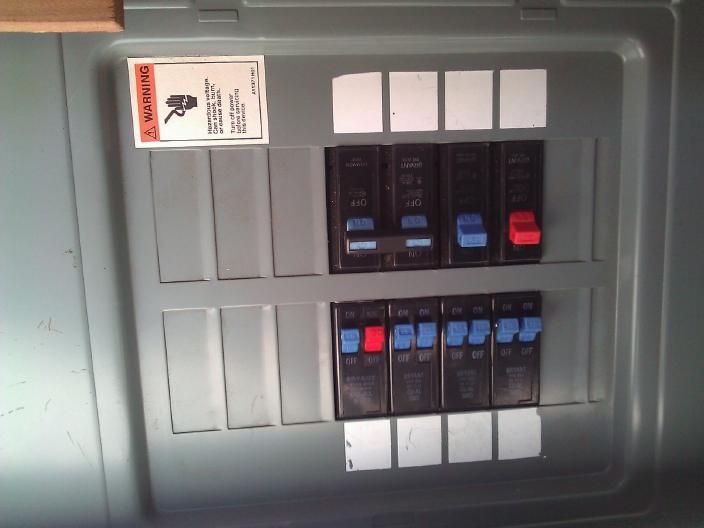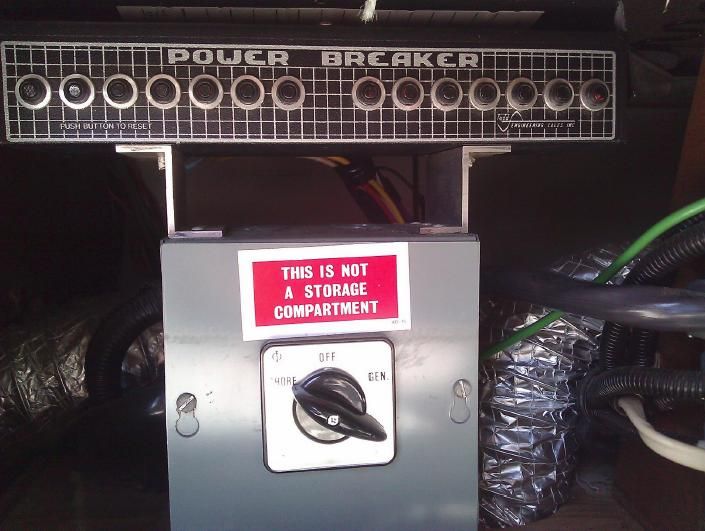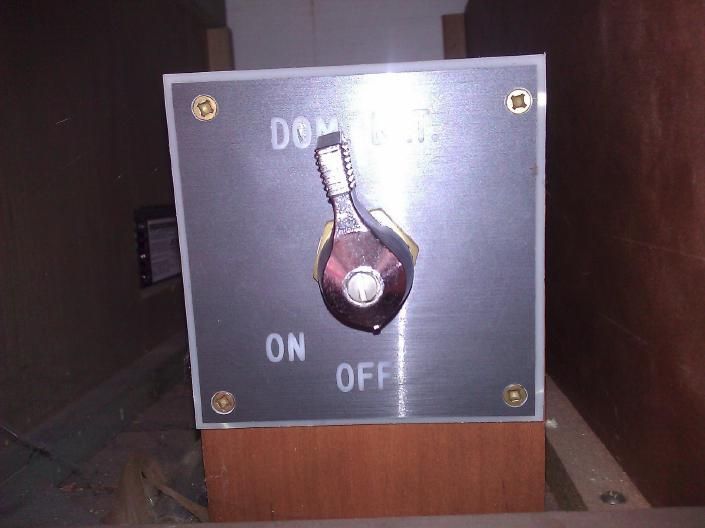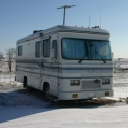Barthmobile Portal
Switches for Winter Storage
10-19-2011, 02:05 AM
Steve CastnerSwitches for Winter Storage
I am trying to figure out which switches to throw in order to isolate all batteries to prevent drain during winter storage.
Here are some possibilities:
1. Large rotating switch in engine compartment. Sorry, I do not have a photo.
2. Dom. Bat. switch beneath dinette seat. Photo attached.
3. Shore/Off/Gen switch beneath sofa. Photo attached.
4. Breaker panel beneath sofa. Photo attached.
Should I switch the engine compartment switch, the domestic battery, the shore/off/gen switch and the breakers all to "off"?
TIA for all the help.

1989 Regal 34’
Side entry, floor plan A
Spartan chassis
Cummins 6CTA – 8.3 L with 240 HP
Cummins pusher
Allison transmission MT 643
Onan generator
8808-3555-34RDS-A
10-19-2011, 02:06 AM
Steve CastnerPhoto of breakers panel.

1989 Regal 34’
Side entry, floor plan A
Spartan chassis
Cummins 6CTA – 8.3 L with 240 HP
Cummins pusher
Allison transmission MT 643
Onan generator
8808-3555-34RDS-A
10-19-2011, 02:07 AM
Steve CastnerPhoto of domestic battery switch.

1989 Regal 34’
Side entry, floor plan A
Spartan chassis
Cummins 6CTA – 8.3 L with 240 HP
Cummins pusher
Allison transmission MT 643
Onan generator
8808-3555-34RDS-A
10-19-2011, 06:00 PM
ccctimtationI have given up on throwing the switches, I have 3 banks, I leave one bank on to power the bilge pumps and disconnect the positive side of the battery going to load for the other two banks. This helps me remember to check water and sp.gr. at spring commisioning. The float charger continues to maintain the batteries since none of the disconnects/switches have been changed.
10-19-2011, 06:50 PM
Steve Castnerquote:
Originally posted by ccctimtation:
I have given up on throwing the switches, I have 3 banks, I leave one bank on to power the bilge pumps and disconnect the positive side of the battery going to load for the other two banks. This helps me remember to check water and sp.gr. at spring commisioning. The float charger continues to maintain the batteries since none of the disconnects/switches have been changed.
Sounds like you can get away without not draining all water and winterizing. That is one difference between Missouri and Wisconsin (other than the fact that the Cardinals got the best of the Brewers).
1989 Regal 34’
Side entry, floor plan A
Spartan chassis
Cummins 6CTA – 8.3 L with 240 HP
Cummins pusher
Allison transmission MT 643
Onan generator
8808-3555-34RDS-A
10-19-2011, 10:17 PM
ccctimtationquote:
Originally posted by Steve Castner:
quote:
Originally posted by ccctimtation:
I have given up on throwing the switches, I have 3 banks, I leave one bank on to power the bilge pumps and disconnect the positive side of the battery going to load for the other two banks. This helps me remember to check water and sp.gr. at spring commisioning. The float charger continues to maintain the batteries since none of the disconnects/switches have been changed.
Sounds like you can get away without not draining all water and winterizing. That is one difference between Missouri and Wisconsin (other than the fact that the Cardinals got the best of the Brewers).
.
Boat stays in the water but it is winterized. There is always potential for either shaft logs to leak or heavy snows driven by wind to build up on aft deck and eventually thaw and partially drain to the bilge.
Like our Harbor Master says: "With a boat in the marina you can come out, sit on the aft deck and enjoy the river. Try that with your camper in the storage lot."
Every year my target for winterization is Pearl Harbor Day. The lag of water temperature versus air temperature often allows this to happen. I generally get friends together for a birthday cruise prior to winterization. RSVP's are being taken for 11/1/11, possibly the following weekend.
Tim
10-19-2011, 10:37 PM
RustyIf you intend to disconnect all the electrics in the coach, the best approach is to disconnect and remove the batteries to warm storage. A discharged battery will freeze at as high a temp as 20°F while a fully charged one will survive down to around -50°F.
The 120VAC switches and breaker box will have no use as long as the water system is winterized. (And if the coach isn't plugged in, they wouldn't matter anyway).
The converter should be unplugged if the batteries are removed and 120VAC left on.
Rusty
 "StaRV II"
"StaRV II"'94 28' Breakaway: MilSpec AMG 6.5L TD 230HP
Nelson and Chester, not-spoiled Golden Retrievers
Sometimes I think we're alone in the universe, and sometimes I think we're not.
In either case the idea is quite staggering. - Arthur C. Clarke
It was a woman who drove me to drink, and I've been searching thirty years to find her and thank her - W. C. Fields
10-20-2011, 10:26 AM
Steve Castnerquote:
Originally posted by Rusty:
If you intend to disconnect all the electrics in the coach, the best approach is to disconnect and remove the batteries to warm storage. A discharged battery will freeze at as high a temp as 20°F while a fully charged one will survive down to around -50°F.
The 120VAC switches and breaker box will have no use as long as the water system is winterized. (And if the coach isn't plugged in, they wouldn't matter anyway).
The converter should be unplugged if the batteries are removed and 120VAC left on.
Good deal. I have a plan. I will put the coach away with fully charged batteries with the engine compartment switch off and the shore/gen switch off. About every two weeks I will turn the switches on and fire up the drive engine and genset (and furnaces) for 45 minutes, which will give me a good opportunity to learn how effective the two furnaces are in Wisconsin winter. That should keep the batteries up, shouldn't it? If I get tired of that, I can head for Florida.
1989 Regal 34’
Side entry, floor plan A
Spartan chassis
Cummins 6CTA – 8.3 L with 240 HP
Cummins pusher
Allison transmission MT 643
Onan generator
8808-3555-34RDS-A
10-20-2011, 09:45 PM
RustyDO NOT run the drive engine while parked - 90% of wear occurs in the first few minutes of running, and cold unloaded idle is worse still. If you run the main engine, drive it at least 10 miles. if you can't drive it, leave the main engine alone. The rule-of-thumb for ANY engine is to get going as quickly as possible, to get it up to operating temps.
The genset is different, since you can load it with space heaters. I take it you can't plug in to shore power? If you can, you can leave the batteries in and the converter energized, and you won't need to run the genset.
Rusty
 "StaRV II"
"StaRV II"'94 28' Breakaway: MilSpec AMG 6.5L TD 230HP
Nelson and Chester, not-spoiled Golden Retrievers
Sometimes I think we're alone in the universe, and sometimes I think we're not.
In either case the idea is quite staggering. - Arthur C. Clarke
It was a woman who drove me to drink, and I've been searching thirty years to find her and thank her - W. C. Fields
10-22-2011, 01:02 AM
Steve Castnerquote:
Originally posted by Rusty:
DO NOT run the drive engine while parked - 90% of wear occurs in the first few minutes of running, and cold unloaded idle is worse still. If you run the main engine, drive it at least 10 miles. if you can't drive it, leave the main engine alone. The rule-of-thumb for ANY engine is to get going as quickly as possible, to get it up to operating temps.
The genset is different, since you can load it with space heaters. I take it you can't plug in to shore power? If you can, you can leave the batteries in and the converter energized, and you won't need to run the genset.
Good point. The truck center that does my work advised me to turn off the Cole Hersee switch to isolate the drive engine battery.
1989 Regal 34’
Side entry, floor plan A
Spartan chassis
Cummins 6CTA – 8.3 L with 240 HP
Cummins pusher
Allison transmission MT 643
Onan generator
8808-3555-34RDS-A


